When it comes to ensuring your electrical safety and proper wiring, choosing the right voltage tester is crucial. With a variety of models available, each offering different features, it can be challenging to find one that meets your needs. Whether you’re a homeowner or a professional, understanding your options helps you make informed decisions. Keep reading to explore the top 10 voltage testers designed to deliver accurate, safe, and reliable results.
Outlet Tester with LCD Display for GFCI Receptacles and Circuit Detection
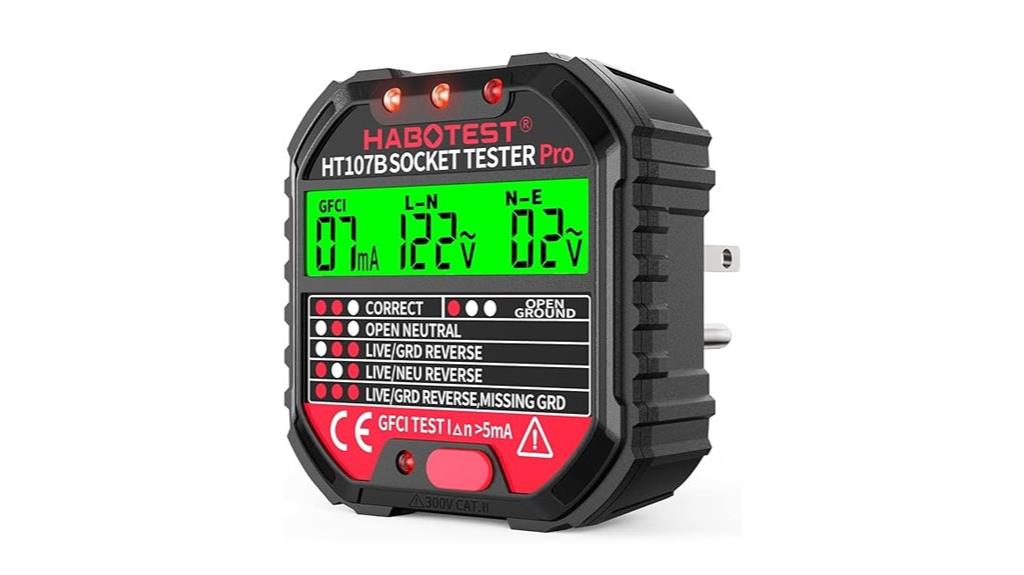
If you’re looking for a reliable outlet tester that simplifies electrical diagnostics, the Outlet Tester with LCD Display for GFCI Receptacles and Circuit Detection is an excellent choice. It works with standard 3-wire and GFCI outlets rated at 90-250V AC, making it versatile for various settings. The bright color LCD shows wiring status with green for correct and orange for issues, plus real-time voltage readings. Its simple plug-and-play design, combined with six indicator lights and a one-click GFCI test, allows you to quickly identify wiring faults and verify breaker functionality. Certified safety standards and a one-year guarantee make it a trusted tool for professionals and homeowners alike.
Best For: DIY homeowners, electrical inspectors, and professionals seeking quick, accurate outlet diagnostics for standard and GFCI outlets.
Pros:
- Easy plug-and-play operation with clear LCD display and LED indicators
- Provides instant wiring status and real-time voltage readings
- Certified to safety standards with a one-year guarantee, ensuring reliability
Cons:
- Size may be less portable for outdoor GFCI cover testing
- Limited to 90-250V AC outlets; not suitable for low-voltage or DC applications
- May require some familiarity for interpreting detailed diagnostics in complex wiring setups
WGGE Digital AC Voltage Tester Screwdriver with LCD Display

The WGGE Digital AC Voltage Tester Screwdriver with LCD Display is ideal for DIY enthusiasts and light electrical workers who need quick, safe wire detection. It combines AC voltage detection (12V-1000V) with an easy-to-read digital LCD display, live wire identification, and break point testing. The built-in flashlight and ergonomic design make it convenient for on-the-go use. Safety alerts, including audible beeps and visual signals, help prevent accidental shocks. While it’s reliable for detecting live wires, its voltage readings can be inaccurate, sometimes showing values ten times higher. Use it mainly for quick checks, not precise measurements or professional troubleshooting.
Best For: DIY enthusiasts and light electrical workers needing quick, safe wire detection and basic voltage checks.
Pros:
- Combines AC voltage detection with a clear digital LCD display for easy reading.
- Includes safety features like audible beeps and visual signals to prevent shocks.
- Compact, lightweight, and ergonomically designed for convenient on-the-go use.
Cons:
- Voltage readings can be inaccurate, often showing values ten times higher than actual.
- Cannot calibrate or adjust voltage measurements, limiting precision.
- Manual is poorly translated, and false positives may occur near non-energized objects.
WGGE AC Voltage Tester with LCD Display and Flashlight
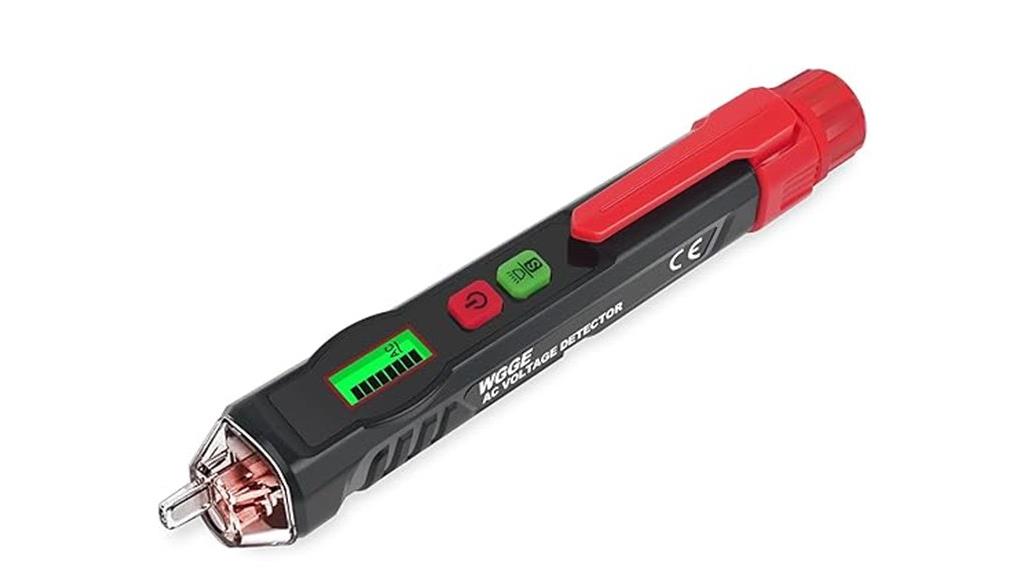
Designed for professionals and DIY enthusiasts alike, the WGGE AC Voltage Tester with LCD Display and Flashlight offers dual-range detection from 12V to 1000V, making it versatile for residential, commercial, or industrial use. It features adjustable sensitivity modes with a simple touch button for accurate readings. The device detects wire faults, live, and null wires efficiently while providing non-contact testing for safety. Its color-coded LCD display shows voltage levels clearly, complemented by audio alerts that increase as you get closer to the source. A built-in LED flashlight helps you work in dim areas, and automatic shut-off conserves battery life.
Best For: both professional electricians and DIY enthusiasts needing a reliable, versatile AC voltage tester for residential, commercial, and industrial applications.
Pros:
- Dual-range detection from 12V to 1000V with adjustable sensitivity for precise measurements
- Non-contact testing ensures safety and ease of use in various environments
- Built-in LED flashlight and automatic shut-off for convenience and battery conservation
Cons:
- May require calibration for highly accurate readings in some settings
- Touch button sensitivity adjustment might be less intuitive for first-time users
- Limited to AC voltage detection; does not measure DC voltage or current
Non Contact Voltage Tester for Outlets and Circuits
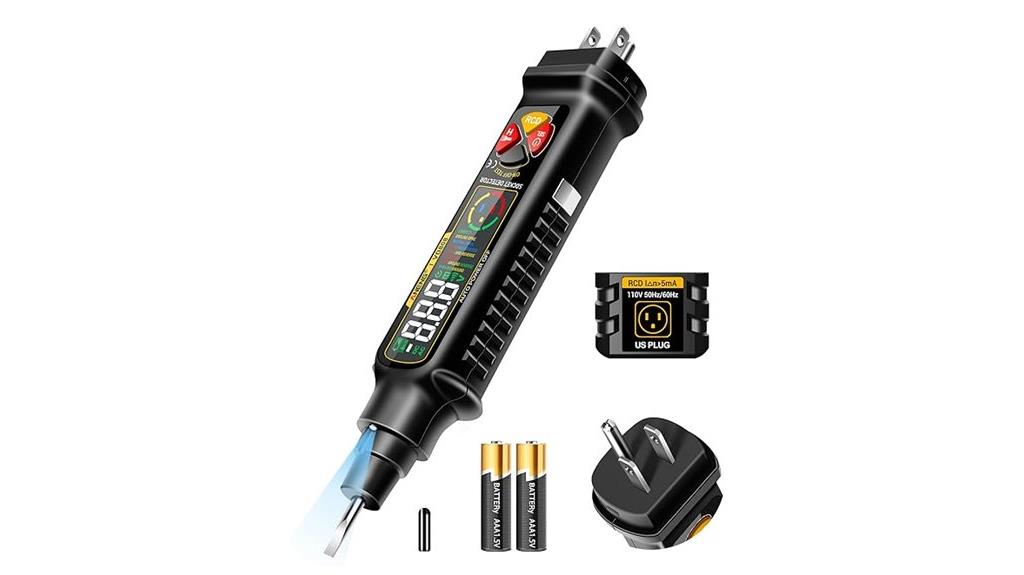
A non-contact voltage tester like the ANENG VD808 offers a quick and safe way to check outlets and circuits without touching live wires. You simply insert the detection pin into sockets or hold it near cables to detect AC signals, with LED indicators and audible alarms confirming presence. Its built-in live wire detector automatically identifies live or neutral wires, while the LCD display shows voltage levels and wiring status instantly. The device also features a breakpoint finder, fuse checker, and polarity tester, making troubleshooting straightforward. Compact and portable, it’s ideal for both professionals and DIY users seeking a reliable, safe testing tool for various electrical inspections.
Best For: DIY enthusiasts, electricians, and safety-conscious homeowners seeking a reliable tool for quick and safe electrical inspections.
Pros:
- Non-contact detection reduces risk of electrical shock during testing.
- Features LCD display, audible alarms, and flashlight for clear, versatile indication.
- Compact and portable design makes it easy to carry and use in various settings.
Cons:
- May require familiarity with electrical testing to interpret signals accurately.
- Limited to AC voltage detection; cannot test DC circuits.
- Battery life may be limited with frequent use, necessitating replacements or recharging.
Klein Tools RT250 GFCI Outlet Tester with LCD Display
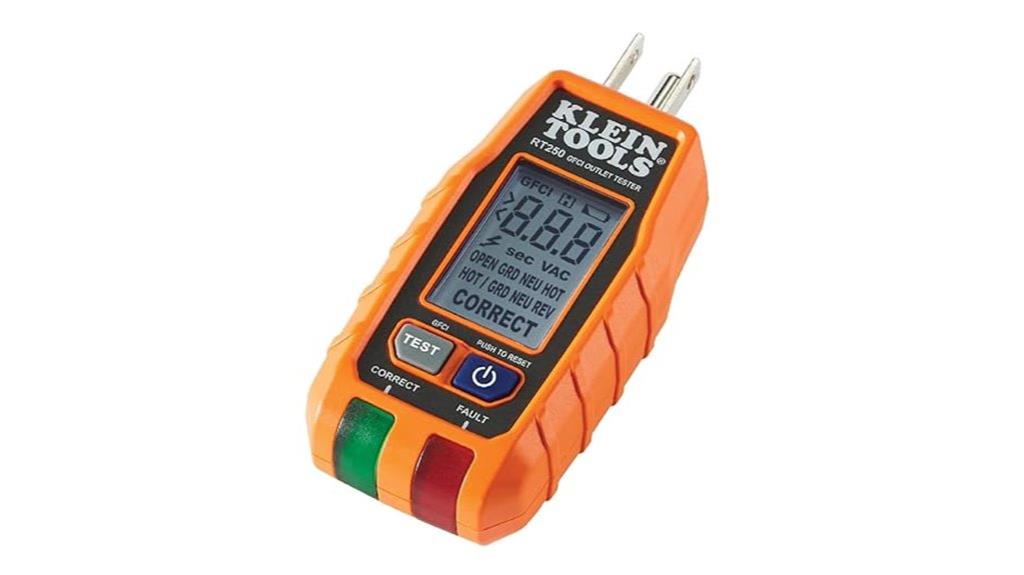
If you’re looking for a reliable GFCI outlet tester that simplifies troubleshooting, the Klein Tools RT250 with LCD display is an excellent choice. Its large backlit LCD makes voltage readings and wiring conditions clear at a glance. Bright green and red LEDs provide immediate visual cues, helping you identify wiring issues quickly. The tester detects common faults like open neutral and ground with a patent-pending system, ensuring safety. It also displays GFCI trip times for precise testing. With an auto-hold function for hard-to-reach outlets and a CAT II 135V safety rating, it offers both convenience and safety for a variety of electrical scenarios.
Best For: DIY homeowners and professional electricians seeking a reliable, easy-to-read GFCI tester for quick troubleshooting and safety verification.
Pros:
- Large backlit LCD display provides clear voltage and wiring condition readings.
- Bright green and red LEDs give immediate visual cues for wiring issues.
- Detects common wiring faults and measures GFCI trip times for precise diagnostics.
Cons:
- Designed specifically for standard 3-wire 120V outlets, limiting use with other configurations.
- Requires batteries, which need replacement over time.
- May be less compact compared to simpler, non-LCD testers.
Sperry Instruments Voltage and GFCI Outlet Tester Kit

The Sperry Instruments Voltage and GFCI Outlet Tester Kit stands out as the ideal choice for electricians and DIY enthusiasts who need reliable, quick verification of AC voltage presence. It features non-contact sensitivity that detects 50-1000V AC and circuit sensing with a patented self-test. Bright, color-coded neon lights provide instant visual cues, while the 360° indicator and beeping alert confirm voltage detection. With a CAT III 300V rating for the GFI tester and CAT III 1000V, IV 600V for the non-contact tester, it’s built for safety. Its durable, ergonomic design includes impact-resistant housing, and the kit contains both testers for comprehensive outlet verification.
Best For: DIY enthusiasts and professional electricians seeking a reliable, comprehensive outlet testing kit with non-contact voltage detection and circuit verification.
Pros:
- Provides quick and accurate verification of AC voltage presence with bright, color-coded indicators.
- Durable and ergonomic design with impact-resistant housing rated for tough job site conditions.
- Includes both GFCI outlet tester and non-contact voltage tester for comprehensive electrical safety checks.
Cons:
- Non-contact voltage detection range may not detect very low or hidden voltages.
- Requires familiarity with electrical testing procedures for accurate interpretation of signals.
- The kit may be overkill for casual users who only need basic outlet checks.
Sperry Instruments GFI6302 GFCI Outlet Tester
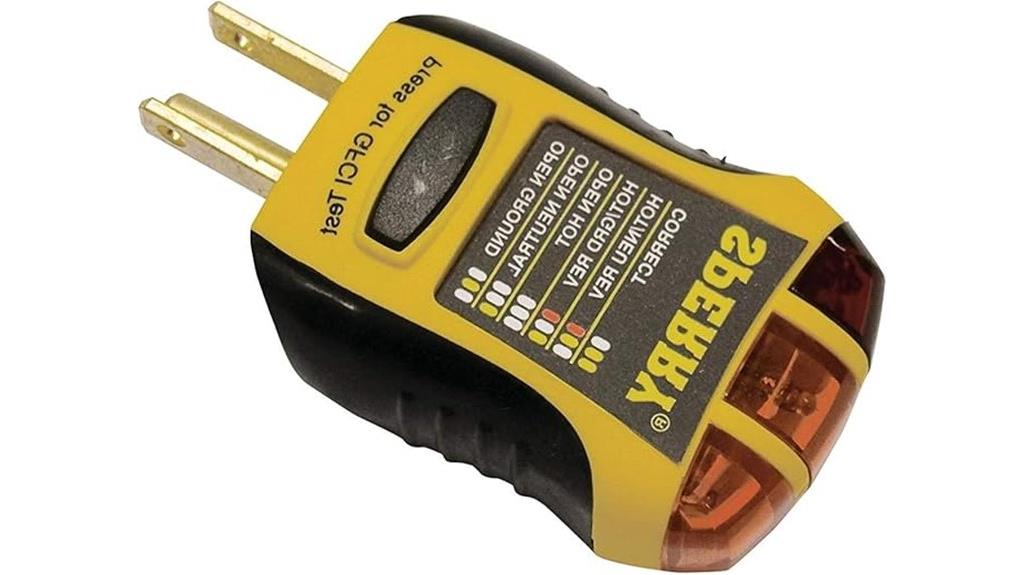
Designed for both homeowners and professionals, the Sperry Instruments GFI6302 GFCI Outlet Tester quickly identifies wiring issues in standard 120V AC outlets, including GFCI-protected ones. Its bright, color-coded neon lights provide instant visual feedback on wiring status, saving you time and effort. The durable ABS housing with soft rubber grips makes it resistant to drops and crushes, ideal for tough job sites. Its compact, ergonomic design ensures easy handling in tight spaces. Certified for safety and reliability with ratings like CAT III 300V, this tester offers peace of mind. Plus, a wiring legend helps you interpret results accurately, making it a versatile addition to your tool collection.
Best For: Homeowners, electricians, and maintenance professionals who need a reliable and easy-to-use tool for testing and diagnosing wiring issues in standard 120V outlets, including GFCI-protected circuits.
Pros:
- Bright, color-coded neon lights provide quick and clear visual feedback on wiring status.
- Durable construction with impact-resistant ABS housing and soft rubber grips for tough job site conditions.
- Compact and ergonomic design allows for easy handling and use in tight spaces.
Cons:
- Limited to testing 120V AC outlets and may not support other voltage ranges or outlet types.
- Does not provide detailed wiring diagnostics beyond basic wiring status indication.
- Requires familiarity with outlet wiring and color codes for accurate interpretation of results.
KAIWEETS Voltage Tester with LCD Display and Buzzer
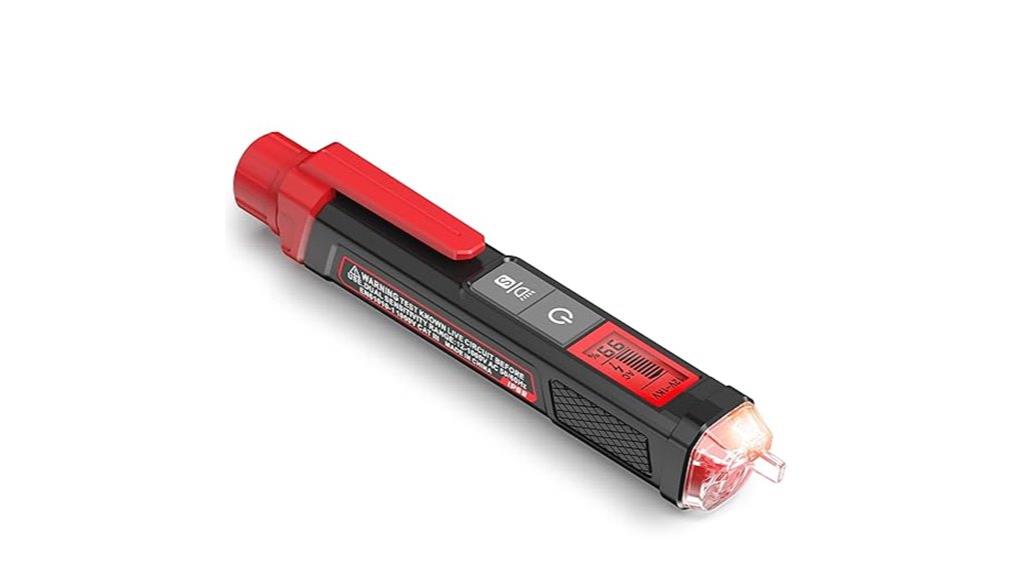
The KAIWEETS Voltage Tester with LCD Display and Buzzer is an excellent choice for electricians and homeowners who need a reliable tool for quickly detecting live wires and ensuring safety. It features multiple alarms, including sound and light indicators, with the LCD screen displaying red for high voltage and green for low voltage. The device automatically detects AC voltage and distinguishes between live and neutral wires without contact. Its compact design includes a flashlight, low-battery indicator, and safety features rated IEC CAT III 1000V and CAT IV 600V. Easy to use and durable, it provides accurate readings for various household and professional electrical applications.
Best For: DIY homeowners and professional electricians seeking a reliable, safe, and easy-to-use voltage tester for quick detection of live wires and circuit testing.
Pros:
- Provides accurate voltage detection with clear visual and audible alarms for safety
- Compact, durable design with handy features like LED flashlight and low-battery indicator
- Automatically distinguishes between live and neutral wires and offers dual-range detection for versatility
Cons:
- Complexity of multiple functions may lead to user errors without proper understanding
- Battery life can be limited, especially if rechargeable batteries are used improperly
- May not detect low-voltage outdoor wiring or DC voltage, limiting outdoor or specialized applications
KAIWEETS GFCI Outlet Tester with LCD Display
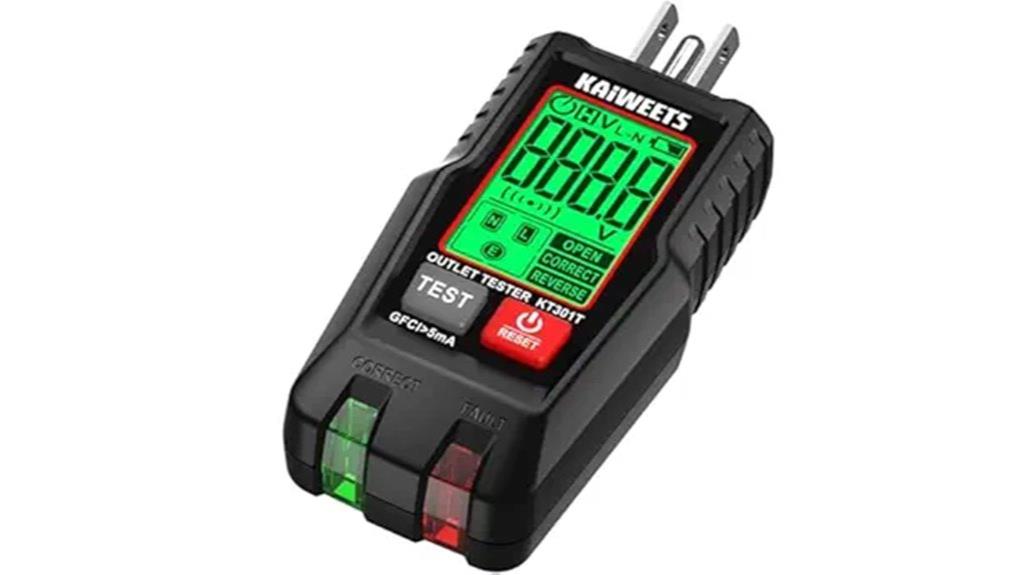
If you’re looking for an easy-to-read and reliable outlet tester, the KAIWEETS GFCI Outlet Tester with LCD Display stands out because it provides real-time voltage readings and clear wiring status indicators. Its vibrant LCD screen shows wiring correctness with green for correct and orange for faults, plus displays voltage levels for quick diagnostics. Designed for North American 3-wire 120V outlets, it detects seven wiring faults, including open ground, open neutral, and reversed wiring. The one-click GFCI test verifies ground fault protection, while the auto hold captures results for hard-to-reach outlets. Compact and durable, it’s perfect for ensuring safe, accurate electrical connections around your home.
Best For: homeowners, DIY enthusiasts, and electrical inspectors seeking a reliable, easy-to-read outlet tester with real-time voltage display.
Pros:
- Clear, vibrant LCD display shows wiring status and voltage readings for quick diagnostics
- Auto hold function simplifies testing in hard-to-reach or tight spaces
- Detects multiple wiring faults and verifies GFCI breaker functionality effectively
Cons:
- LCD screen could be brighter for improved visibility in very low light conditions
- Polls voltage slowly compared to professional tools, not suitable for rapid fluctuation detection
- Requires battery replacement over time, though batteries last several weeks with normal use
Klein Tools RT110 Outlet Tester

For electricians and homeowners who need quick, reliable outlet testing, the Klein Tools RT110 Outlet Tester offers an easy-to-read light sequence that clearly indicates wiring correctness or issues. Designed for North American outlets supporting 110/125V AC at 50/60Hz, it simplifies troubleshooting by instantly revealing wiring problems. The tester complies with UL Std 1436 and CSA Std C22.2 #160, ensuring safety and quality. Its durable construction withstands drops from 6.6 feet and operates well in temperatures from 32°F to 140°F. With straightforward indicators, it provides accurate, fast results, making it an essential tool for safe and efficient outlet inspections.
Best For: electricians and homeowners seeking quick, reliable outlet testing to ensure wiring safety and proper functionality.
Pros:
- Easy-to-read light sequence for straightforward troubleshooting
- Conforms to UL Std 1436 and CSA Std C22.2 #160 for safety and quality
- Durable construction withstands drops from 6.6 feet and operates in wide temperature ranges
Cons:
- Only compatible with North American 110/125V AC outlets
- Limited to standard receptacle testing, not suitable for GFCI or specialized outlets
- May require additional tools for complex wiring issues
Factors to Consider When Choosing a Voltage Tester for AC Outlets
When choosing a voltage tester for AC outlets, you need to consider factors like voltage range compatibility and safety certifications to ensure reliable and safe operation. Ease of use features, display clarity, and the ability to detect wiring faults also play a crucial role in making an effective choice. By evaluating these points, you can select a tester that meets your needs and keeps you safe during testing.
Voltage Range Compatibility
Choosing a voltage tester with the right detection range is essential to ensure accurate and safe measurements of AC outlets. Make sure the tester covers the typical voltages in your area, usually between 90 and 250V for residential settings. If you work with different circuits, consider models that support dual or multiple voltage ranges, such as low (12V-1000V) and high (48V-1000V), for versatility. Confirm that the device’s maximum voltage capacity exceeds your highest expected voltage to prevent damage or inaccurate readings. Look for testers with adjustable sensitivity or multiple modes to detect various voltage levels accurately. Lastly, verify that the tester complies with local electrical standards, ensuring it can safely handle the specific voltage ranges in your region.
Safety Certifications Needed
Selecting a voltage tester that meets safety standards ensures you’re protected during testing. Look for certifications like CAT III or CAT IV, which indicate the device can handle high-energy transients and electrical faults safely. Certifications from recognized labs such as UL, CSA, or CE confirm the tester meets international safety standards. A certified tester should also comply with IEC safety norms and feature double or reinforced insulation, reducing the risk of electric shock. Safety-rated testers explicitly display their maximum voltage and environment ratings, like CAT II 125V or CAT III 600V, showing their suitability for specific electrical setups. Always verify that these certifications are current and clearly marked on the packaging or manual before use to ensure your safety during testing.
Ease of Use Features
Ease of use is a crucial factor when picking a voltage tester for AC outlets, as it ensures you can get accurate readings quickly and safely. Look for testers with clear displays, like LCD screens or LED indicators, that show wiring and voltage status at a glance. Automated features such as auto shut-off, push-button GFCI testing, and auto detection simplify operation and minimize errors. An intuitive interface with few buttons makes it easier for DIYers and homeowners to operate without confusion. Bright, backlit displays or indicator lights improve visibility in dim or hard-to-reach areas, allowing you to read results easily. Additionally, clear labeling, simple instructions, and ergonomic design boost user comfort and confidence during testing, making the process safer and more efficient.
Display Clarity and Readability
A clear and easy-to-read display is vital for accurately interpreting voltage readings and wiring conditions. Look for testers with large, high-contrast characters that remain legible in various lighting conditions, including bright or dim environments. Backlit or illuminated screens improve visibility in dark or tight spaces, reducing the risk of misreading measurements. Digital displays that provide precise voltage values offer more detailed diagnostic information than simple indicator lights. Consistent and stable readings are essential to avoid confusion caused by flickering or fluctuations. Additionally, user-friendly interfaces with straightforward symbols and minimal ambiguity help you quickly understand the readings at a glance. Prioritizing display clarity ensures safer, more accurate assessments of electrical conditions.
Detection of Wiring Faults
When choosing a voltage tester for AC outlets, ensuring it can accurately detect wiring faults is crucial for electrical safety. A dependable tester should identify issues like open ground, open neutral, reversed polarity, and missing live wires, preventing potential hazards. Look for testers that use clear visual indicators such as LED lights, LCD screens, or color codes to promptly reveal wiring problems. Advanced models may also verify GFCI trip functionality and measure trip times to confirm proper ground fault protection. Compatibility with standard voltage ranges—typically 90-250V AC—and certification to safety standards like CAT II or CAT III are essential for reliable detection. Quickly and reliably identifying wiring faults helps you avoid electrical accidents and ensures your system functions correctly.
Portability and Size
Choosing a voltage tester that is portable and appropriately sized can significantly enhance your convenience and efficiency. A compact device easily fits in your pocket or tool belt, making on-the-go inspections quick and hassle-free. Lightweight testers reduce fatigue during extended use and allow for precise maneuvering in tight spaces. Their pocket-sized design enables fast checks without bulky equipment, saving you time and effort. Smaller testers are also more versatile, ideal for testing confined or hard-to-reach outlets and circuit breakers. Conversely, larger models might include extra features but can be cumbersome to transport, store, or operate in tight or outdoor environments. Prioritizing the right size ensures your tester complements your tasks, boosting safety, accuracy, and overall convenience.
Additional Safety Functions
Incorporating additional safety functions into your voltage tester is essential for minimizing electrical hazards during inspections. Non-contact voltage detection helps you avoid accidental shocks by alerting you to live wires without direct contact. Built-in alarms, like audible beeps and visual indicators, provide instant warnings of voltage presence or wiring faults, enhancing safety. Some testers feature fuse check or circuit breaker trip verification, ensuring protective devices work correctly and reducing risks. Safety-rated testers that conform to standards like CAT III or CAT IV are suitable for high-voltage environments, offering added confidence. Integrated functions such as live wire detection, polarity testing, and fault identification allow you to quickly spot issues, reducing the chance of accidents. These features make your testing safer, faster, and more reliable.
Price and Warranty
Price and warranty are important factors to consider when selecting a voltage tester for AC outlets. Higher-priced models often come with extended warranties, offering better long-term protection and peace of mind. While budget options may be cheaper upfront, they usually have limited or no warranty coverage, which could lead to extra costs if repairs or replacements are needed later. Quality testers with comprehensive warranties are typically tested rigorously for accuracy and durability, reflecting the manufacturer’s confidence in their reliability. Warranties ranging from one to three years are common and signal a product’s dependability. Balancing price and warranty helps you choose a tool that’s both cost-effective and supported by reliable coverage, ensuring you get a safe and accurate device that lasts.
Conclusion
Choosing the right voltage tester ensures your safety and accurate readings. Whether you prefer a simple non-contact detector or a advanced LCD display model with GFCI testing, there’s an option for you. Focus on safety certifications, ease of use, and durability to find the best fit. With the right tool, you can confidently diagnose outlets and prevent electrical hazards. Stay safe and make informed decisions with these top-rated voltage testers.





